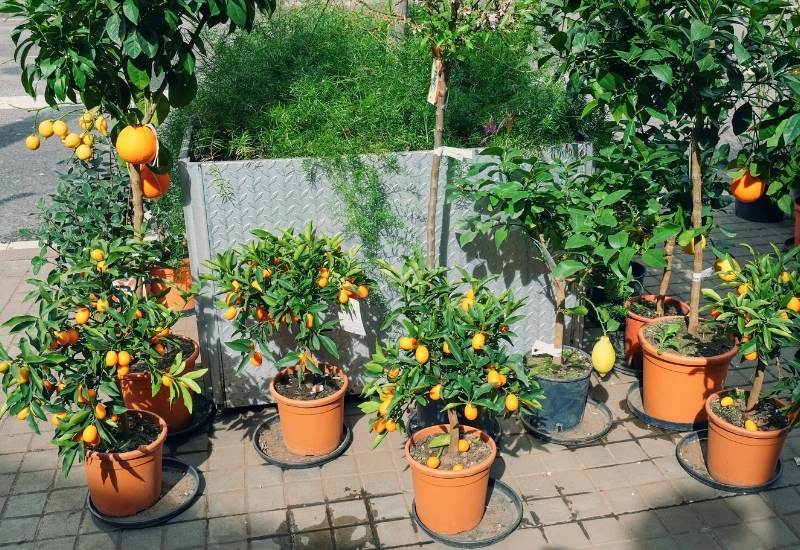
Lemon trees are typically grown in tropical or subtropical regions, but if you live in a colder area and want to enjoy homegrown lemons, you can learn how to grow lemon trees in pots and best of all It’s easier than you might imagine.
When you grow lemon trees in containers, it allows you to grow them in any environment. You can bring them inside when the weather starts to get colder, and they make a fragrant, beautiful houseplant, or you can grow them outside year-round if they have the right climate.
If you’ve always wanted to try growing lemons at home but felt like you couldn’t because of your climate, you can do it! This guide shows you everything you need to know about growing lemon trees in pots.
Learn How To Grow Lemon Trees In Pots
If you’ve never grown fruit trees on pots before, lemon trees are an excellent choice for beginners.
They are relatively easy to grow, and they aren’t too picky about conditions. Trust me; learning how to grow lemon trees in pots is easier than you might imagine.
1: Choose Dwarf Varieties Of Lemon That Are Perfect For Container Growing
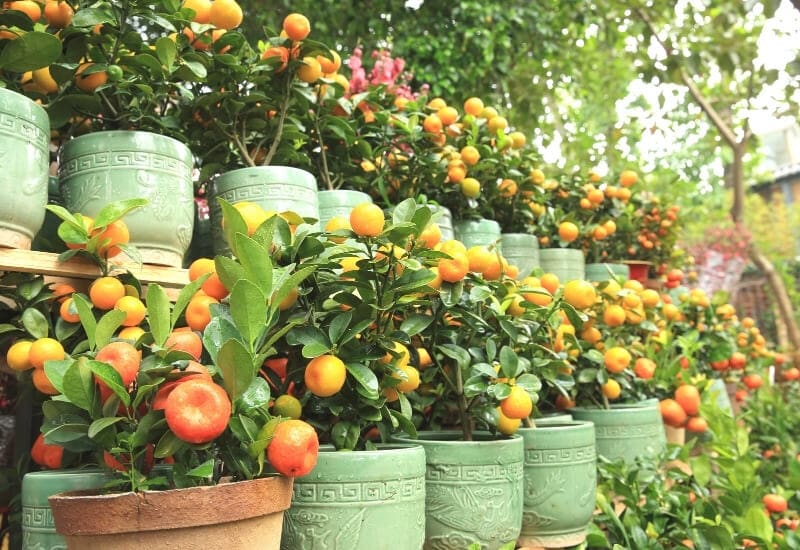
When you grow a lemon tree in a pot, it’s not going to get as large as the ones grown in the ground.
While you can grow any type inside your house – the conditions will cause the tree size to be limited – it’s best to select dwarf lemon tree varieties for optimal growth.
Growing lemon trees in pots have become more popular over the past few years, and gardeners identified several varieties that do exceptionally well in pots.
Ideally, you’ll want to start with trees that are 2-3 years old. This is the age when they are mature enough to produce fruit, but you still might need to wait a year or two before fruit appears. The trees will be small, but they will grow, even dwarf varieties.
1. Start With A 12-Inch Diameter Container With Proper Drainage
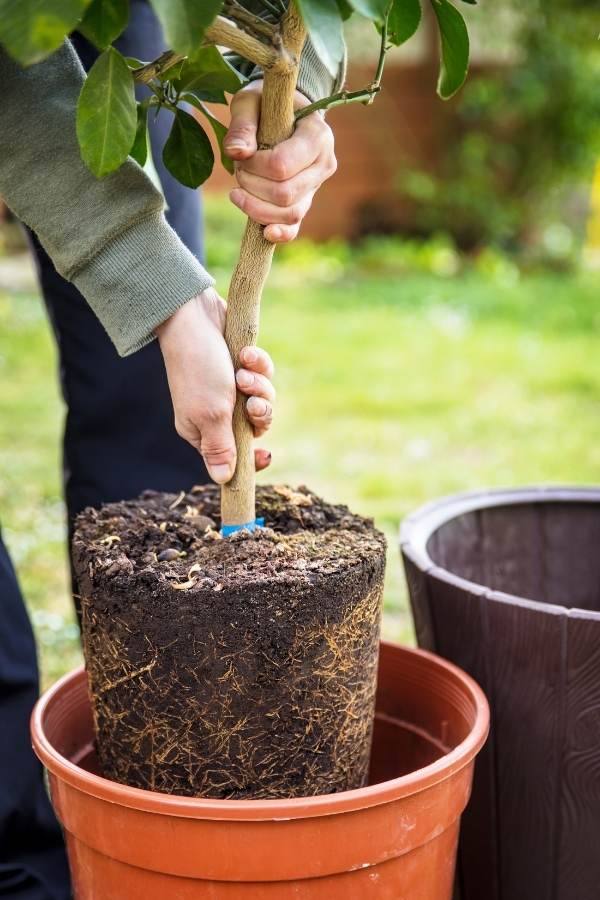
Perhaps one of the most critical factors when selecting a container for lemon trees is drainage. They need good drainage, so pick one that has several drainage holes.
You will need to repot your tree every few years or at the beginning of spring. In warmer climates, winter is the best season to repot your trees.
Avoid using a pot that is too big or too small for your tree. It should only be one size bigger than your previous pot.
2. Place The Pot In A Warm, Sunny Location
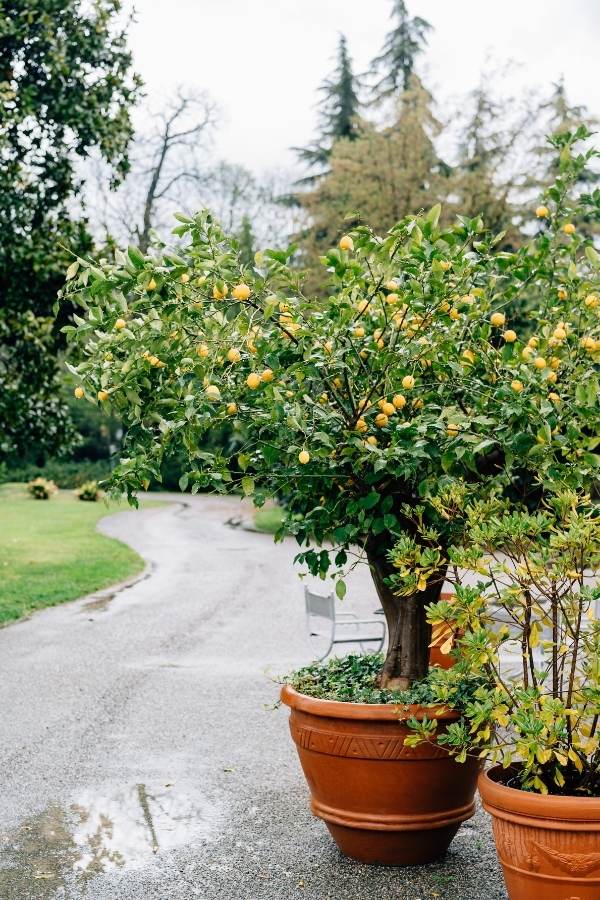
You can keep your citrus trees outside when the weather is warm and frost-free. Potted lemon trees need to be kept in a spot that receives 6-8 hours of direct sunlight per day.
3. Fill Container With Well-Draining Potting Mix
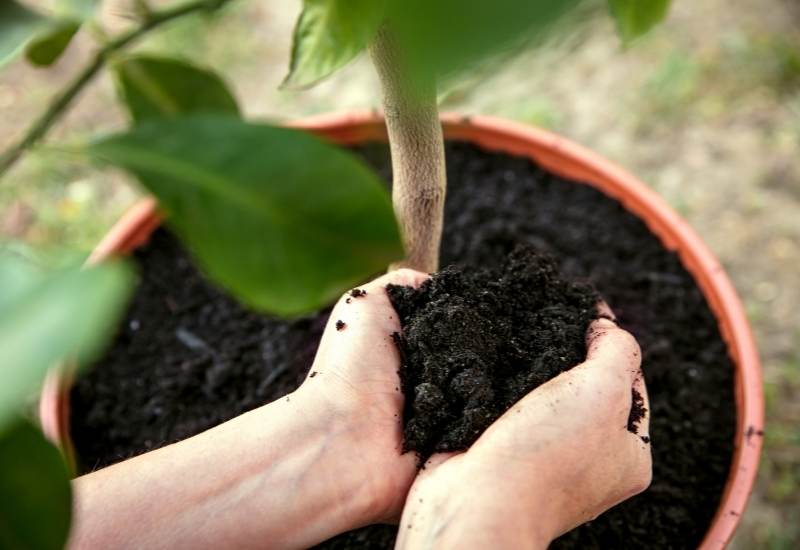
You want to get the soil right the first time with your lemon tree. Garden nurseries sell potting mixes created for cactus, palms, and citrus trees, containing a balance of ingredients designed to retain moisture while also draining freely.
4. Planting Lemon Trees In Containers
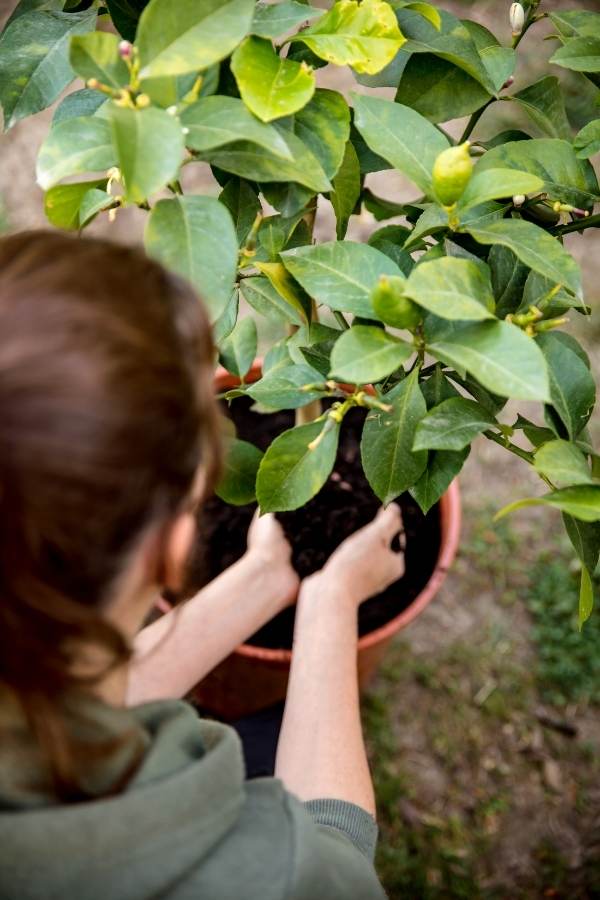
You can only plant your trees one time in your container, so you want to do it right. Planting depth is vital to understand because citrus trees need plenty of air circulation.
Take a look at your tree and find where it starts to flare out at the base; this should be slightly exposed.
Caring For Potted Lemon Trees
Lemon trees make a fantastic container plants, and they don’t require an excessive amount of care. You have to remember to water and fertilize when needed and prune once a year. That’s not too bad!
1. Keep The Soil Moist And Never Let It Dry Out Completely
Lemon trees prefer to have consistent, regular watering. If the soil dries out too much, the leaves will fall off of the plant. It’s best if their soil is evenly moist, but they should never be soggy.
2. Fertilize Your Lemon Trees
A crucial part of growing a healthy lemon tree is using fertilizer. Before planting, you should add compost to your soil for the initial nutrients needed for growth, but that’s not all you need to do.
3. Don’t Forget About Pollination
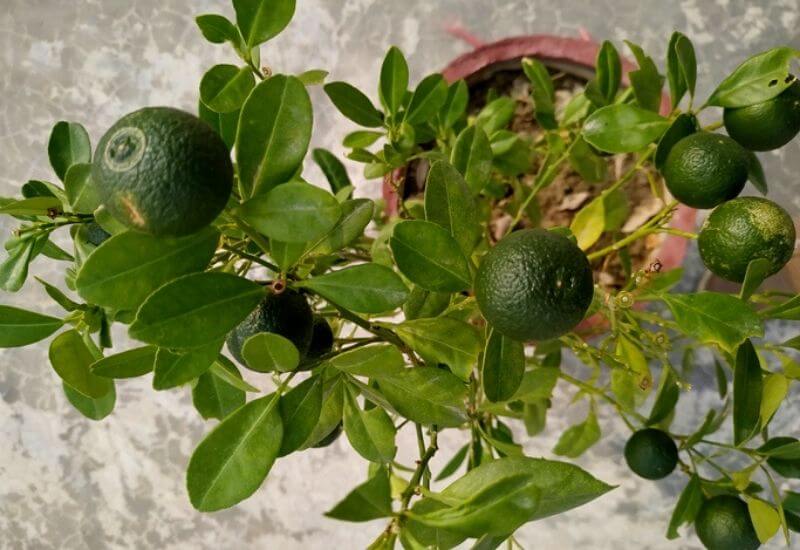
Lemon trees bloom in the winter, and there aren’t as many pollinators inside of your home. If you have to bring your plant inside for the winter because of your climate, you need to hand pollinate.
You can use an electric pollination tool if you want, but hand-pollinating each flower is simple, but it’s often overlooked by those new to growing citrus trees inside.
4. Overwinter Inside
If you live in USDA zones 8b-11, you don’t need to worry about overwintering and cold temperatures too much.
Zones below that require special care because of the cold, harsh winters. Temperatures below 30℉ are life-threatening for lemon trees, but the “Meyer” tree can tolerate as cold as 24℉.
Lemon trees are vulnerable to cold weather and drought, so when wintertime hits, you’ll need to bring your trees inside away from the cold weather.
While lemon trees growing in the ground can handle mild frost, container-grown ones cannot tolerate lower temperatures.
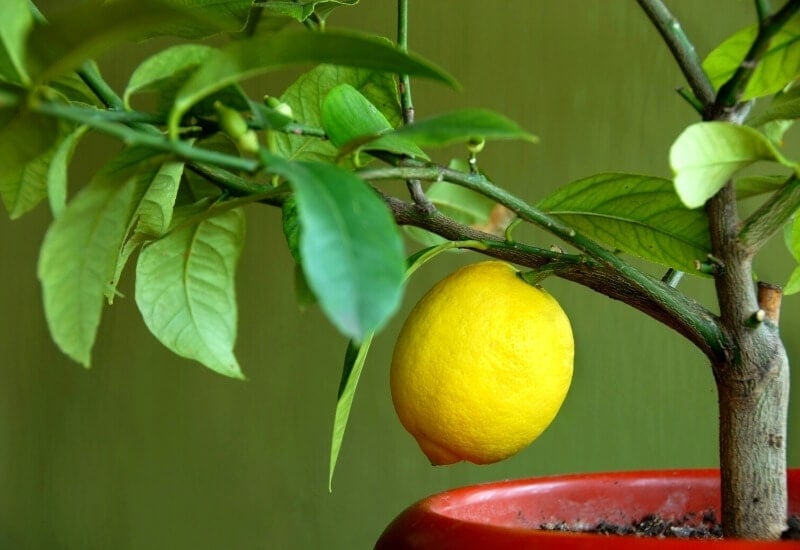
If your trees start to drop some or all of their leaves, don’t be surprised. They can do this whether you move them inside or outside; it’s a natural process as the plant adjusts to different light levels.
Your tree will soon produce leaves better suited to the new level of light; just be patient with your plant.
5. Prune As Needed
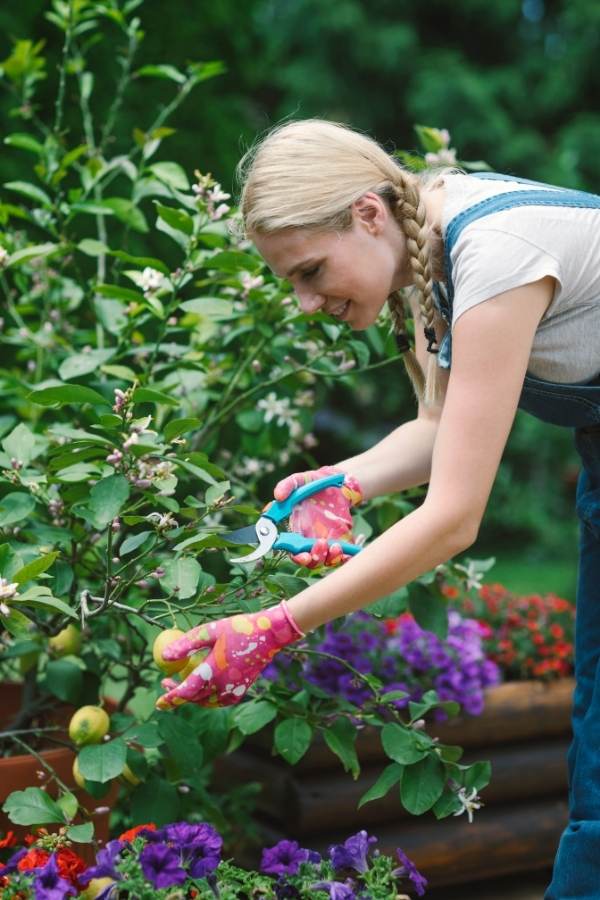
Pruning is needed for all fruit trees; citrus trees are no exception to that. Regular pruning limits the tree size and encourages larger fruit. Wait until your tree starts to flower before pruning; you don’t want to cut off your fruits.
Harvesting Fresh Lemons At Home
One benefit of growing fresh lemon at home is that many cultivars bear fruit year-round, such as the Meyer lemon tree. The main harvest takes place between the middle of November and the middle of April.
The trees are highly productive in colder areas, spreading the harvest more throughout the year. For those in warm climates, the harvest is concentrated in the fall and early winter.
Common Pests & Diseases That Bother Lemon Trees
Citrus trees are vulnerable to many pests and diseases, but you do decrease the risks of both when you grow them inside. Here are some of the most common pests and diseases that bother lemon trees.
Citrus Canker
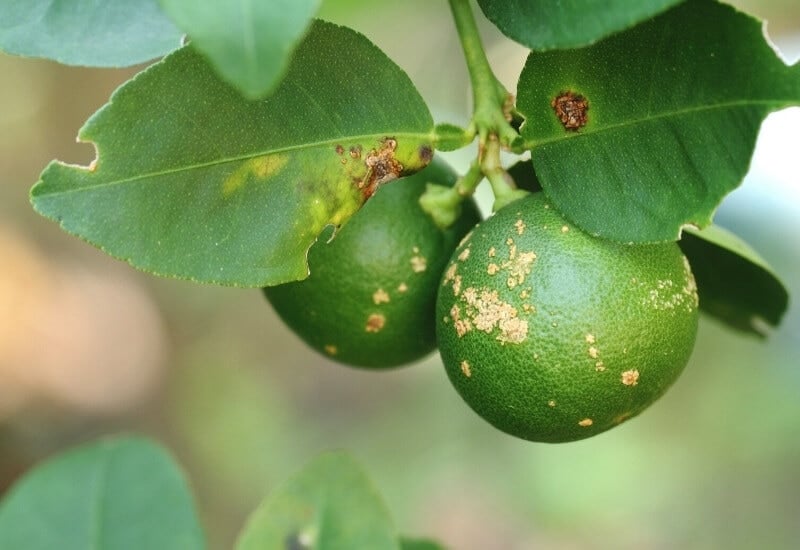
Citrus canker is a highly contagious bacterial infection that leads to halo-like lesions or scabs on the leaves, twigs, and fruit of citrus trees.
If your plant has a severe infection, it can cause leaf loss, blemished fruits, or tree dieback. Citrus canker spreads quickly through the wind, insects, birds, and humans, so it can easily become a problem.
You can use various sprays to protect your tree from infection, such as a liquid copper fungicide, but it’s just a preventative treatment.
The problem with this bacterial disease is that it moves fast once your trees are infected, destroying trees before the bacteria spreads.
Melanose
This is a fungal infection that bothers young, citrus fruits. While it does typically infect primarily grapefruits, lemons aren’t immune to this fungus. Melanose is more severe in older trees, ones that are over ten years old because it prefers deadwood.
You can reduce melanose by regularly pruning to combat the disease. Another option is to use a liquid copper fungicide as a preventative treatment.
Greasy Spot
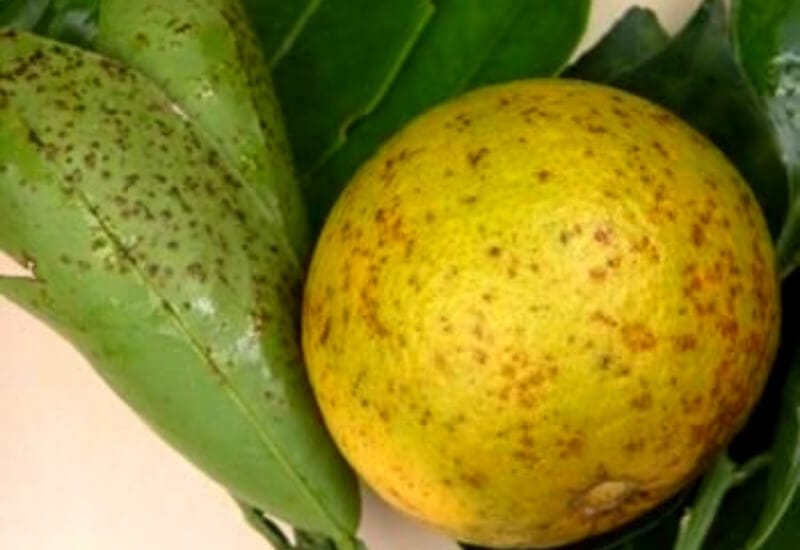
Here is another fungal disease that bothers citrus fruit trees. You’ll know that you have greasy spot if you have yellowish-brownish blister spots on the leaves, mainly the leaves’ underside. As the disease progresses, the spots develop an oily look.
When your plants have a greasy spot, it can cause significant leaf loss, especially during the winter, and it also infects the fruits of the plant.
If you want to control this disease, you have to collect and get rid of all fallen leaves; this reduces new spores that could infect your plant.
Then, spray your plant with liquid fungicide in June or July; you might need a second application in August or September.
Sooty Mold
Sooty mold is a fungus that develops when pests leave behind honeydew secretions on your trees and plants.
Aphids, whiteflies, and mealybugs are common pests that secrete honeydew as they suck on sap out of your plants.
Sooty mold rarely kills your plants, but the insects that cause it can damage or destroy your plants.
Once you take care of your pest problem, you can wash away the plants’ blackened mold with soap and water. You also can use a liquid copper fungicide or Neem oil to treat your lemon trees.
Aphids
One of the most common pests that infect lemon trees are aphids. In small numbers, they won’t cause serious problems, but their population grows rapidly, which can damage your citrus trees during their primary growing season.
Apids suck out the sap from your leaves, causing puckered marks, yellowing, and curling. The leaves look deformed and ugly.
You can knock aphids off of your tree with jets of water, or you can use some new insecticide to spray your plants.
The sprays should be applied to the leaves’ underside, and it only takes one or two applications to get rid of an aphid infestation.
Citrus Whiteflies
If you see tiny, white-winged insects that measure around 1/12 of an inch, you more than likely have citrus whiteflies.
They swarm out when you shake the branches of your trees, and they also lay eggs on the leaves’ underside. Then, once they hatch, the juvenile whiteflies suck the leaves’ sap, leading to curled leaves.
One way you can control citrus whiteflies is with insecticides, but it also takes several applications. It’s essential to take control of these pests because they secret honeydew, leading to sooty mold.
Orangedog Caterpillars
These are large caterpillars that measure up to 2 inches in length with a brown color.
They attach to the citrus trees and start to eat the leaves; you’ll know it’s orangedog caterpillars when the leaves appear to be eaten or chewed from the outer edges inward.
You should remove any caterpillars on your tree that you see by hand. You should know that they don’t smell the best, but it’s the best control method. You also can use an insect spray that contains spinosad or Bacillus thuringiensis as organic control methods.
Citrus Thrips
If your tree is infected with citrus thrips, the first thing you’ll notice is shriveled leaf buds and leaves that are curled and distorted.
They often have a silvery grey color on the leaves and a silvery color scabbed or streaked on the fruit.
Citrus thrips are orange or yellow, small in size, primarily attacking young leaves and juvenile fruit.
The adults lay their eggs in the fall, and the juveniles hatch in the spring, immediately feeding on the leaves and fruit. Their damage is most notable during hot, dry weather.
To control citrus thrips, you can spray the trees with insect spray with spinosad, but you need several repeat applications to control the population fully.
Citrus Bud Mites

If you live in a coastal region, citrus bud mites might become your archnemesis.
They’re small, elongated insects that peak in the summer, so fall blooms are at risk.
It’s hard to detect these tiny insects, but you can find them if you closely inspect your fruits. You’ll need to use an insecticide to control the population.
Final Thoughts
When gardeners branch into growing houseplants, many don’t consider growing lemon trees in pots indoors, but they are fragrant, beautiful houseplants that also provide you with delicious fruits.

Written By
Amber Noyes
Amber Noyes was born and raised in a suburban California town, San Mateo. She holds a master’s degree in horticulture from the University of California as well as a BS in Biology from the University of San Francisco. With experience working on an organic farm, water conservation research, farmers’ markets, and plant nursery, she understands what makes plants thrive and how we can better understand the connection between microclimate and plant health. When she’s not on the land, Amber loves informing people of new ideas/things related to gardening, especially organic gardening, houseplants, and growing plants in a small space.

The rims of my lemon tree leaves are turning kind of yellow – it is around the edges on almost every leaf. There are no insects on it. The tree is 1 year old, in a planter pot and has been in the house all winter. This problem has just started about a month ago, before I moved it outside.
Any thoughts as to what could be causing it?
Of course it is a chlorosis as the leaf has a yellow tip, but many things cause chlorosis. This is often due to not watering with enough water. You should water until water runs out of the pot. Otherwise, the water evaporates and leaves salts behind. This is made worse if fertilizer is included in the water. You can rinse the salts away by watering with copious amounts of water. like 2 – 3 volumes of the pot.
Thank YOU for a wonderful, detailed article on lemon trees in pots! We are venturing on our first and really want to make sure we’re doing right by these wonderful trees. Thanks again, really appreciate the insights and guidance
cheers
jamie
Thanks for the most informative notes on how to care for lemon trees in pots. I live in the south of France but am new to the environment here and to having the opportunity to grow this amazing plant. So it is great to get your advice. Thanks again.
I have a plant, I believe it’s a lemon & it has prickers, why is this. I’ve had these plants for at least 3 years & no blossoms, how long should it take?
Excellent post, very informative and helpful.
I was thinking about planting my lemon into the garden every spring and lifting it every autumn. I would use a pot without a base so it could more reliably access the soil for water and nutrients. Also more sun than the veranda.
Your thoughts on this, maybe crazy, idea?